
On the cover The eye of a cuttlefish. The chromatophores, the sense organs that allow the animal to quickly change color and camouflage itself, are in frantic activity to try to distract the photographer, which, in this case, is detected as a predator.
Night time... On the sand

And as the first shadows of the evening fall, dive begins to be different, strange, indefinite, fascinating. The instinctive reluctance of thinking to be in a black liquid overcomes. And nighttime someone goes hunting, someone else seems to be talking. While dark surrounds everything here are some casual or real couples, or real. In the sea, phenomena of life between animals belonging to the same or different species frequently occur. It is not just for reproduction and perpetuation of the species.
Reasons are often of self-defence. It is the universal law of those who have no law, if not instinct: eating, do not be eaten, spawning. Two mullets (Mullus surmuletus) appear to have argued, and are in plastic pose in front of the lens.
(Praiano - Salerno)
 Two Chromis seem two wives looking out the window.
Two Chromis seem two wives looking out the window.
 A pair of twin crustaceans Scyllarus arctus appears quite surprised as they were two illicit lovers.
A pair of twin crustaceans Scyllarus arctus appears quite surprised as they were two illicit lovers.
(Praiano - Salerno)
 Two hermit crabs (Pagurus prideaux) with the typical sea anemone mantle (Adamsia palliata) below of the shell, seem to face each other in a boxing match.
Two hermit crabs (Pagurus prideaux) with the typical sea anemone mantle (Adamsia palliata) below of the shell, seem to face each other in a boxing match.
(Puolo bay - Sorrento)
 ... and then, maybe, two fellws looks like a couple at first, but in it is alone, and in danger as well. Here it is a crab, a common Portunus hastatus half-sanded and with its claws extended towards the photographer in a clear defensive attitude. Roberto, my diving partner, after having photographed the crab as well, delicately lifted the back of the crustacean cleverly avoiding its claws.
... and then, maybe, two fellws looks like a couple at first, but in it is alone, and in danger as well. Here it is a crab, a common Portunus hastatus half-sanded and with its claws extended towards the photographer in a clear defensive attitude. Roberto, my diving partner, after having photographed the crab as well, delicately lifted the back of the crustacean cleverly avoiding its claws.
I saw, then, that the carapaces were two, not one as it seemed before . "They’re mating!" I thought, but looking better I noticed that under the abdomen was not another specimen, but… another abdomen. And then I understood, finally, that the sea was giving us a great gift. We were watching the carapace mute, an event that regularly involves crustaceans when they grow up, and their old armor becomes too small.
It is difficult to catch the show because the animals carefully seek shelter, since they are undefended for a few hours, until the carapace has hardened. That night our crab friend had been lucky: we were big, but just “paparazzi”, prying and observing, nothing more. He did not even try to escape, and it was fascinating to see a crab that, little by little, became two. It and its carapace were identical, the only detail that allowed to detect the empty shell from the full one were the eyes, that are the only anatomical part the animal preserves. In the end it was tender to see it facing and leaving its recent past.
(Praiano - Salerno)

The decorator crab Pisa nopides is a martyrdom for the photographer. Finding it is a real challenge, since, like the counterparts tropical, he goes around carrying with him algae, sponges or what else it finds up to disguise completely. Only an inadvertent movement makes it discovered, and then it becomes easy to shot, because continuing to trust his mimicry, it lies still.
(Capo d’Orso - Salerno)

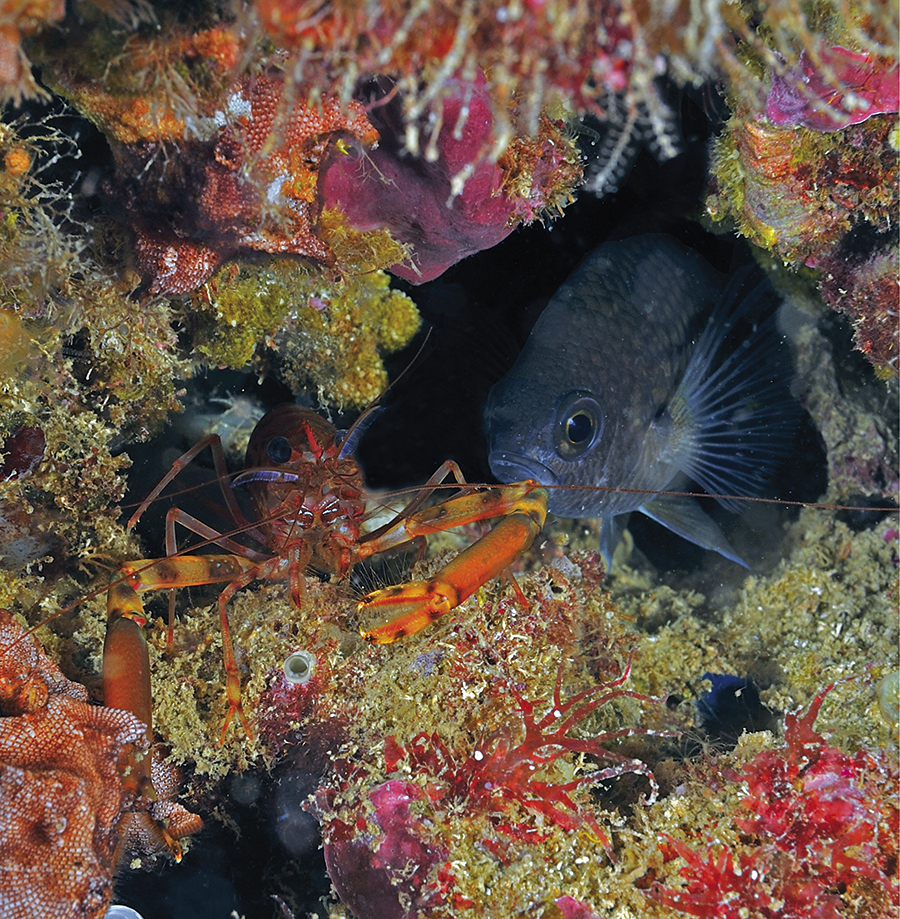 A situation that reversed roles, recalls, the typical case of symbiosis of the tropical seas between gobies and shrimp, where the first is a sentinel at the entrance of the den and the second with his powerful claws digs a gallery into the sand to escape in case of attack by a predator. It is certainly not the case of the brown damsel fish (Chromis) and the rare
A situation that reversed roles, recalls, the typical case of symbiosis of the tropical seas between gobies and shrimp, where the first is a sentinel at the entrance of the den and the second with his powerful claws digs a gallery into the sand to escape in case of attack by a predator. It is certainly not the case of the brown damsel fish (Chromis) and the rare
Brachycarpus biunguiculatus meeting. The taken moment is surely result of an
accident, but the aggressive look of crustacean and the shy one of the fish make you think to a collaboration between species, fish and crustaceans, similarly to the frequent tropical behaviors.
(Praiano - Salerno)

A parapandali (Plesionika narval) school. The only chance to meet them in so abundant swarms forming an abstract picture with their bodies, colors and antennae is night time or in the caves.
(Capri - Naples)

Parapandali colors are bright, but it’s not easy at all to isolate a single sample during swimming and, perhaps resume it frontally, when graphics and color given by the legs and antennae are extremely captivating.
(Korcula island - Croatia)
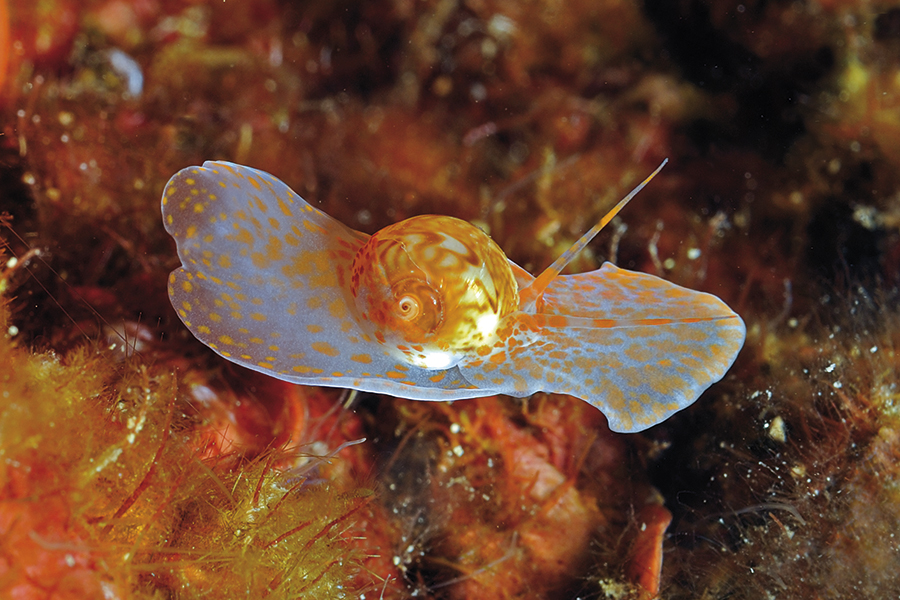 Shellfish have cloaks and colors of such a beauty leaving sometimes no way out even to the noble tropical relatives, if it were not . . . for sizes. The superb specimen of shell portrait (Notocochlis dillwynii) was about half inch long.
Shellfish have cloaks and colors of such a beauty leaving sometimes no way out even to the noble tropical relatives, if it were not . . . for sizes. The superb specimen of shell portrait (Notocochlis dillwynii) was about half inch long.
(Puolo Bay - Sorrento)

The cimazio spotted snail - Monoplex parthenopeus - or leopard snail, is a gastropod clam getting, the most beautiful coat of the Mediterranean. It is surely rare but there are two details more, that makes almost undiscovered: it has a rather large shell covering it even when it is moving, and the periostraca - ie the outer part of the shell that is made with organic material - is completely covered by thick hair.
This means that when the animal feels the presence of a stranger and stops, it is practically indistinguishable from the rocky substratum it is used to live on: it is not about camouflage, the fact is that it becomes one with the rock... You need to observe to observe sudden
movements, while at night it can happen that you meet him hunting for starfish, its favorite food. If one turns the opening upwards its natural instinct, overturning it with the opening upwards. The natural instinct to resume the natural position allows you to admire all the magnificent cloak.
(Sorrento coast)

And talking about nocturnal encounters, the one with the owl fish (Dactylopterus volitans) is certainly among the most wanted. It uses the two pectoral fins grown beyond measure and have a fantastic coloring, like capon fish, but it is definitely more rare.
It flies away if the bother on duty becomes too intrusive. Its not negligible special feature is the almost absolute similarity with the counterparts tropical owl fish, both morphologically and for biology. The origin of the name is discussed. Surely it’s not because the fish can fly out of the water, that’s characteristic only of the so-called “flying” fish. According to many people, the vulgar name is due to the characteristic plaintive verse, similar to the one of the nocturnal bird of prey, the fish emits when it is captured and taken out of water...
 ... but looking at the shot on the next page, the writer’ sensation is that, thanks also to the crushed snout, the resemblance with the flying owl is really impressive.
... but looking at the shot on the next page, the writer’ sensation is that, thanks also to the crushed snout, the resemblance with the flying owl is really impressive.
(Praiano - Salerno)
 ...and in a sand hole full of stones here is an octopus (Octopus vulgaris). It is strangely into the den, while it usually night time octopuses come out hunting, and it has a threatening look to photographer.
...and in a sand hole full of stones here is an octopus (Octopus vulgaris). It is strangely into the den, while it usually night time octopuses come out hunting, and it has a threatening look to photographer.

 And here is the gurnard (Chelidonichtys lucernus) in its nighttime livelier, literally walking on the front ends and bumping into the dome of the housing. Under pectoral fins it has some rays become real “legs”, it walks on the sand with. The function of these “accessories” is uncertain. Some think that they are useful to dig on the sand in search of food, others that they allow the fish to stay higher and to see more in the distance. Basically it hunts by walking and escapes by flying.
And here is the gurnard (Chelidonichtys lucernus) in its nighttime livelier, literally walking on the front ends and bumping into the dome of the housing. Under pectoral fins it has some rays become real “legs”, it walks on the sand with. The function of these “accessories” is uncertain. Some think that they are useful to dig on the sand in search of food, others that they allow the fish to stay higher and to see more in the distance. Basically it hunts by walking and escapes by flying.
(Reggio Calabria)

We were in a group, during a night dive in one of the “paradises” of the so-called “muck dives”, that literally means “diving on the mud seabed”. In great fashion in the depths of the Pacific. Marina Grande in Sorrento is impassable during summer months. Wintertime it is a “land” of conquest for the ones in search of underwater biological emotions.
An incredible life by shape and color wanders among the wrecks of chairs and various furnishings, including bicycles.
That evening, thanks to the north wind of the previous days, water was very clear. Light beams cut darkness, cold cut off legs. Between a shot and a tremor I saw a superb specimen of Alicia mirabilis, a sea anemone with a sublime night dress.
It was enormous, it would have been impossible for me to take it all over, but the charm of the very long, stinging tentacles got the better of it, and, as if hypnotized, I approached. Nearby it was a sand star, beautiful at all, the comb star (Astropecten bispinosus), so called
because of the pointed appendages of his arms. It is a relatively common encounter, and then I woke up from hypnosis, I looked around: no one; a look at the dive computer: 172 feet. Situation highly inadvisable, according to trivial reasonableness, but, but, but, what was moving on that star? I glimpsed a very particular and not much documented situation in the Mediterranean: a yellow spotted “vintner shrimp” (Gnatophyllum elegans) fed on the mantle of the star, taking advantage of the detritus that the animal raises while sliding on the sand.
He looked at me, with an expression mixed between the fearful and the intrigued.
This “show” is very common in tropical seas, where small crustaceans living and feeding on various sea anemones and echinoderms are frequently documented. My behavior was really unwise, but I could not help but frame and shoot.
A long decompression was waiting for me, but I no longer felt the slightest chill of cold.
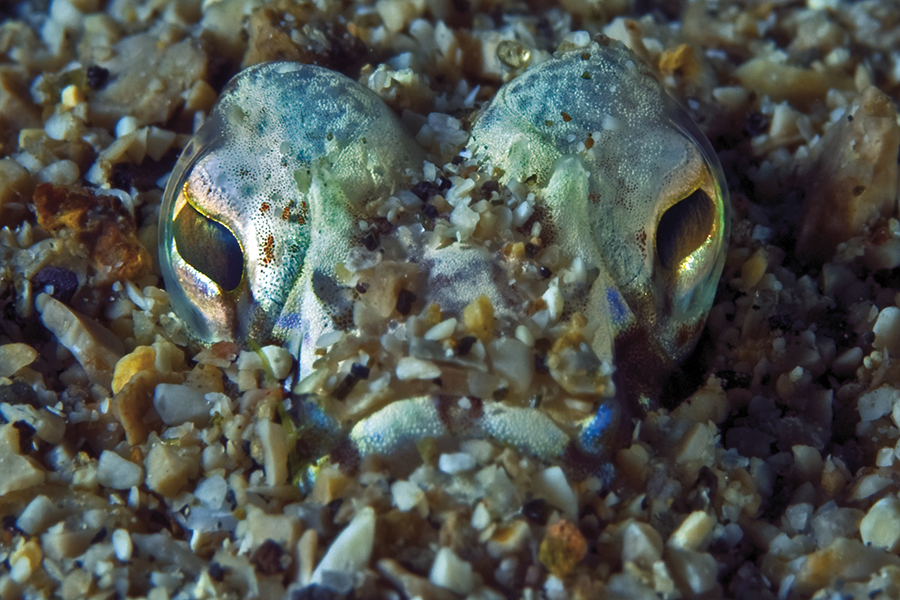 The weever (Trachinus draco) in spite of the shape it takes in the image, where it recalls a heart, is a predator, really feared by swimmers, even in the tropics, because of the painful wounds that can result if accidentally a foot approaches its dorsal spine. Although considered
The weever (Trachinus draco) in spite of the shape it takes in the image, where it recalls a heart, is a predator, really feared by swimmers, even in the tropics, because of the painful wounds that can result if accidentally a foot approaches its dorsal spine. Although considered
aggressive towards even larger subjects, I never met a single fellow chasing me because of the reckless approach aimed to get an interesting shot.
(Palau - Olbia)

February, night, cold and muddy water, no one around, neither above, nor under the veil of water, except me and my friend Antonio. A few subjects but suddenly I see myself literally fixed by two small eyes. Never seen such a little moray eel (Muraena Helena). The tiny tube worms above his head, about one inch long, they can make the idea of the size of the young fish. Its shy, curious and helpless expression look made me think that I should be the first human “beast” it saw in his life. (Praiano - Salerno)
 The Blennius ocellaris blenny is definitely one of the most beautiful fish in the Mediterranean. It lives on the sand, unlike the “co-workers” we’ll meet in ascent, that prefer the rock and the holes where they find shelter. The most impressive feature is because of the dorsal fin, that looks like a sail. When fish is quiet, fin is really in rest position ...
The Blennius ocellaris blenny is definitely one of the most beautiful fish in the Mediterranean. It lives on the sand, unlike the “co-workers” we’ll meet in ascent, that prefer the rock and the holes where they find shelter. The most impressive feature is because of the dorsal fin, that looks like a sail. When fish is quiet, fin is really in rest position ...
(Palau - Olbia)
 ... while it is “hoisted” when it warns danger. And in this case, here is the false eye, exactly as it happens to the family of tropical butterfly fishes. It is a defense strategy: predators try to hit the fish near the head, and then the eye: they would attack a soft and retractable part, allowing the prey an immediate escape.
... while it is “hoisted” when it warns danger. And in this case, here is the false eye, exactly as it happens to the family of tropical butterfly fishes. It is a defense strategy: predators try to hit the fish near the head, and then the eye: they would attack a soft and retractable part, allowing the prey an immediate escape.
As is known, the most of fishes gets the swim bladder, which plays in their body an important function, allowing the animal to be balanced without needing continuous swimming. It’s a little bit what divers do using dive jackets, which, depending on the air inside, allow to be weightless at any depth. Blennies haven’t swim bladder, that’s the reason why they naturally tend to “sink”. They move on the seabed with little jumps, or they prefer standing into holes in the rock where they take refuge. It is strange to think, associating it with a so small fish, that sharks are the most famous example of fishes devoid of swim bladder. They are convicted to perpetual motion.
(Scilla - Reggio Calabria)
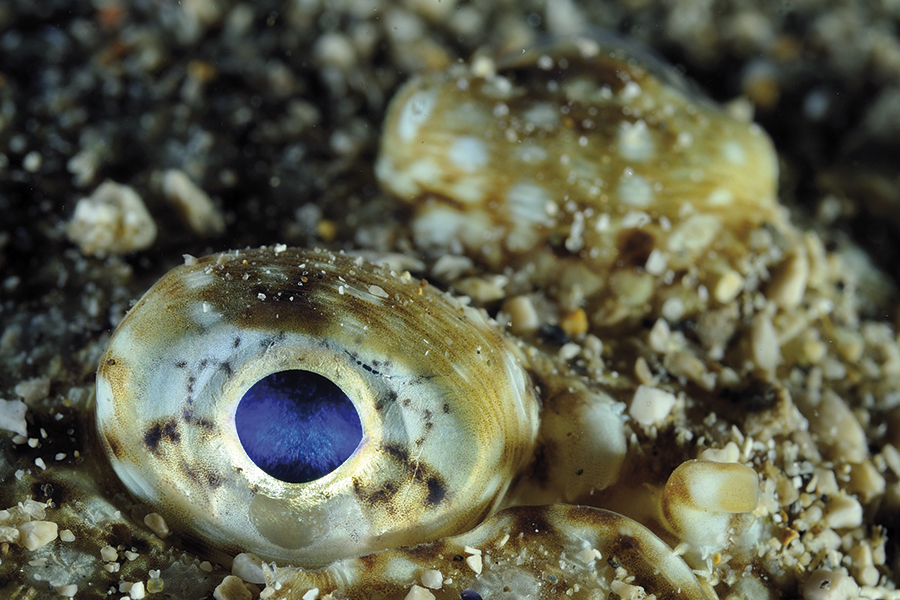
Eyes of the flat fish living on the sand, like the eyed sole (Microchirus ocellatus) take strange nuances.
They seem like telescopes of a submarine as they turn around, to keep shoulders under control.
(Praiano - Salerno)
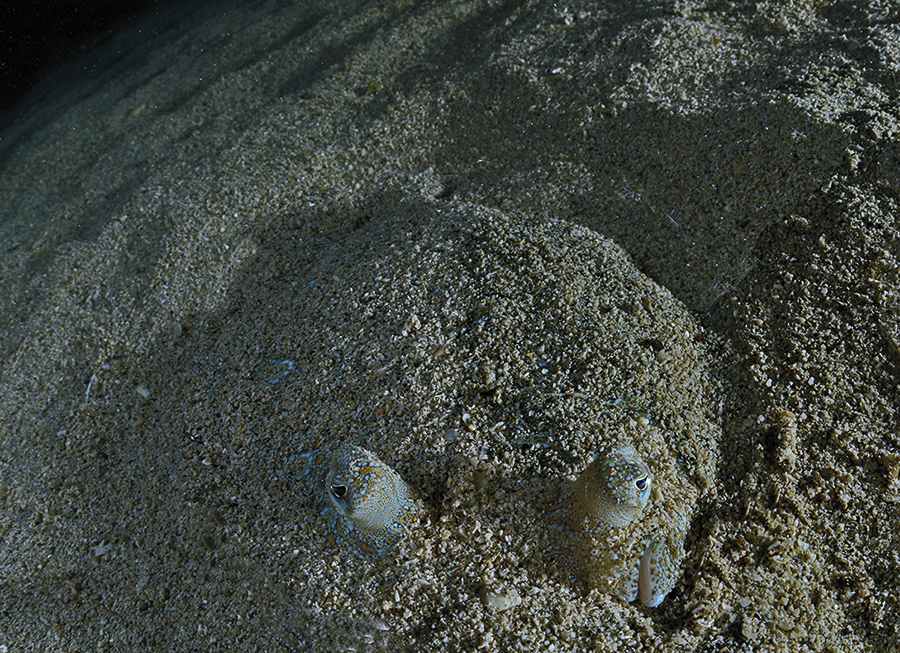 The Bothus podas is a typical sand fish, widespread in the various oceans. It is difficult to spot subject because of its spectacular camouflage, but easy to photograph because of its… presumption.
The Bothus podas is a typical sand fish, widespread in the various oceans. It is difficult to spot subject because of its spectacular camouflage, but easy to photograph because of its… presumption.
A curious feature of flatfish is that at the time of birth the larva has eyes on the two sides of the body, like all other fishes. When they grow, in addition to take a horizontal swimming position, an eye moves where it is needed. It is perhaps a typical example of a millennial evolution. (Ventotene - Latina)

 The spotted eagle ray (Raja montagui), is another typical inhabitant of the sand world. Tropical specimen is very common in the Red Sea where it seems a psychedelic carpet for its blue spots.
The spotted eagle ray (Raja montagui), is another typical inhabitant of the sand world. Tropical specimen is very common in the Red Sea where it seems a psychedelic carpet for its blue spots.
The Mediterranean one, with black polka dots seems a starry sky. Its eye is spectacular, because with the unlikely eyelashes inevitably catches..
(Puolo bay - Sorrento)

 Talking about eyes, the one of a common cuttlefish (Sepia officinalis) is a kaleidoscope of shades and colors. (Tremiti islands - Foggia)
Talking about eyes, the one of a common cuttlefish (Sepia officinalis) is a kaleidoscope of shades and colors. (Tremiti islands - Foggia)
Seen in sequence, the shots show the obvious “sandy” habits of the three species, while their eyes seem to
communicate the progressive... drowsiness of the subjects.
 The aracnanto (Arachananthus oligopodus) is perhaps the most wanted sea-anemone by underwater photographers, because of its relative rarity. In fact it is reported almost exclusively along the Sorrento and Tyrrhenian coasts of Reggio Calabria, as well as, apparently, in... the Red Sea (the Arachananthus lilith). It is an exclusively nocturnal animal and reports a double color of the tentacles, silver and brown, and can be found by chance on the mud, ready to retreat as soon as it is lighted. When I took the shot I had glimpsed it, at a depth of about 138 feet, while a cloud of small misidiac shrimps was nearby. Perhaps it had just captured one and it was withdrawing inside the tube to digest it, anyway it was taking on a strange and decidedly graphic appearance. A few seconds later it had totally gone under the sand. (Puolo Bay - Sorrento)
The aracnanto (Arachananthus oligopodus) is perhaps the most wanted sea-anemone by underwater photographers, because of its relative rarity. In fact it is reported almost exclusively along the Sorrento and Tyrrhenian coasts of Reggio Calabria, as well as, apparently, in... the Red Sea (the Arachananthus lilith). It is an exclusively nocturnal animal and reports a double color of the tentacles, silver and brown, and can be found by chance on the mud, ready to retreat as soon as it is lighted. When I took the shot I had glimpsed it, at a depth of about 138 feet, while a cloud of small misidiac shrimps was nearby. Perhaps it had just captured one and it was withdrawing inside the tube to digest it, anyway it was taking on a strange and decidedly graphic appearance. A few seconds later it had totally gone under the sand. (Puolo Bay - Sorrento)

 There is so much clamor, moreover justifiable, for new discoveries occurring day by day in the tropical seas, Indonesia, Philippines and Papua in particular, but it can only make reader smiling to know that some recently classified species have their counterparts in the Mediterranean, where they are more unknown that in the Pacific. This is the case of the so-called “mimic” or “wonderpus” indonesian
There is so much clamor, moreover justifiable, for new discoveries occurring day by day in the tropical seas, Indonesia, Philippines and Papua in particular, but it can only make reader smiling to know that some recently classified species have their counterparts in the Mediterranean, where they are more unknown that in the Pacific. This is the case of the so-called “mimic” or “wonderpus” indonesian
octopus, the small octopus with thin and very long tentacles they have adopted as a defensive strategy assuming aspects and shapes of others animals, such as starfish, cuttlefish, etc. Well, the
Macrotritopus defilippi, is almost unknown even in the Mediterranean. It’s a small octopus with quite similar
characteristics to the peculiars of the tropical wonderpus or mimic one. Only when it is forced to swim, in case of the shot caused by the photographer, it is possible to appreciate the subtlety of its tentacles with a single series, and not two, of alternating suckers, unlike the “real” octopus (Octopus vulgaris).
Once “landed” I succeeded to take just three shots in a few seconds. It seemed very strange to me observing through the viewfinder of the SLR, an octopus imitating a starfish, and becoming sand.
(Marina Grande - Sorrento)
 The Jonh dory (Zeus faber) is a very popular prey not only for hunters but for photographers too ... It is an inhabitant of the depths, but at night it rises to more accessible bathymetries for humans, and stunned by lights it allows some shots. Then it’s possible to appreciate all its peculiarities: the flat shape, the long dorsal fins, the black spot it owes its name to. The legend – that is scientifically more than improbable - in fact, identifies the digital fingerprint of the saint who would have touched the fish after having caught it. In short it is a fish of “monstrous” beauty and sacredness.
The Jonh dory (Zeus faber) is a very popular prey not only for hunters but for photographers too ... It is an inhabitant of the depths, but at night it rises to more accessible bathymetries for humans, and stunned by lights it allows some shots. Then it’s possible to appreciate all its peculiarities: the flat shape, the long dorsal fins, the black spot it owes its name to. The legend – that is scientifically more than improbable - in fact, identifies the digital fingerprint of the saint who would have touched the fish after having caught it. In short it is a fish of “monstrous” beauty and sacredness.
(Praiano – Salerno; Marina Grande - Sorrento)
 A shy little specimen of cuttlefish one inch long (Sepiola rondeletii). It lives on the sand and it’s almost invisible when it’s camouflaged.
A shy little specimen of cuttlefish one inch long (Sepiola rondeletii). It lives on the sand and it’s almost invisible when it’s camouflaged.
(Praiano - Salerno)
 When they are alive squids (Loligo vulgaris) show an exasperated activity of the chromatophores, the organs allowing camouflage species to change color. In the tropical seas it is easy meeting them even in daylight, while in the Mediterranean they are rarely and just night time within reach of the photographic lens.
When they are alive squids (Loligo vulgaris) show an exasperated activity of the chromatophores, the organs allowing camouflage species to change color. In the tropical seas it is easy meeting them even in daylight, while in the Mediterranean they are rarely and just night time within reach of the photographic lens.
Attracted by underwater torches, a superb specimen approaches (central shot) hoping that near light there are anchovies and planktonic crustaceans on which it feeds.
(Cetara – Salerno)
In the background (on the top right) two cephalopods suddenly move away as soon as they realize that light comes out from someone not really edible!
(Marina di Puolo – Sorrento)

They really look real aliens, not in technical sense, that is, coming from other seas, but in the classical sense, that is coming from other worlds. Mollusks and crustaceans shots taken in lucky encounters, sometimes in the dephts, during their juvenile stage, if not even larval, seem to belong to other galaxies. These are mostly nocturnal meetings, currently very fashionable in the tropics, where some great photographers recently became specialized in these so-called “black dives”. You floats in total darkness, and it is
fascinating, even if not reassuring, observing a few inch creatures swimming in water ink, and feeling, in the dark, very small, exactly like them.
top left: A colony of planktonic tunicates (Thalia democratica).
(Giglio island)
In the upper center a not identified specimen larval crustacean, measured about an half inch. (Praiano - Salerno)
bottom: A larval specimen of spotted needlefish (Nerophis maculatus), practically one inch long ribbon.
(Ustica island)
top center: A tiny larval sample of an unidentified crustacean.
top right: jellyfishes appear floating in interstellar space (Ventotene island)
 Can an easy and small sandsmelt to be an unforgettable sight? Yes, of course, to lovers of the sea and photographers. It’s easier to fish it rather than to photograph. It is very difficult shot, because of the speed it moves and the ease the silver body “shoots”, that tends to scary overexposures. It was alone, plankton hunting. It allowed me to get a quick close shot. Little by little it climbed up to the surface, creating an absolutely fantastic reflex, a question of a one hundred and fifth of a second ...
Can an easy and small sandsmelt to be an unforgettable sight? Yes, of course, to lovers of the sea and photographers. It’s easier to fish it rather than to photograph. It is very difficult shot, because of the speed it moves and the ease the silver body “shoots”, that tends to scary overexposures. It was alone, plankton hunting. It allowed me to get a quick close shot. Little by little it climbed up to the surface, creating an absolutely fantastic reflex, a question of a one hundred and fifth of a second ...
(Praiano - Salerno)

A Pelagia noctiluca jellyfish attacks a Thalia democratica specimen. It is a dramatic scene, proving that the actual trend of blackwater dives off the shores of Philippines, Lembeh strait and Florida can give satisfaction in Mediterranean sea too. I remember a fantastic book issued some years ago by Christopher Newbert, entitled “In a raimbowed sea”. It contained more than one shot taken off the shores of Kona, in Hawaii. At that times pelagic creatures, juvenile stages and biologic associations in blackwaters were held as unique.
The scene made the photographer think if the gregarious habit of the various specimens of Thalia democratica is due, as it happens among little pelagic fishes,, to self-defense reasons, since when animals are in a larger group they are more difficult to attack. (Praiano – Salerno)


